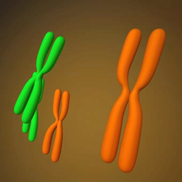
chromosome / chromosomes; eukaryotic chromosome; eucariotic chromosome; procariotic chromosome
A
chromosome is a single, long molecule of DNA. These highly organized structures
store genetic information in living organisms. Small sections of the
chromosome, called genes, code for the RNA and protein molecules required by an
organism. In some organisms, like humans, chromosomes are linear, but in other
organisms, like bacteria, chromosomes are typically circular. In prokaryotes,
the circular chromosome is contained in the cytoplasm in an area called the
nucleoid. In contrast, in eukaryotes, all of the cell's chromosomes are stored
inside a structure called the nucleus. Each eukaryotic chromosome is composed
of DNA coiled and condensed around nuclear proteins called histones. Humans
inherit one set of chromosomes from their mother and a second set from their
father. In total, most human cells contain 46 chromosomes with 22 pairs of
autosomes, or non-sex chromosomes, and two sex-determining chromosomes. The sex
chromosomes in humans are called X and Y. Females carry two X chromosomes,
while males carry one X and one Y chromosome. Cells of the body that contain
two sets of chromosomes are called diploid. Meanwhile, germ line cells, which
go on to produce egg or sperm cells, are called haploid because they contain
half the chromosomes of diploid cells. Chromosomes are often observed and
depicted as X-shaped structures. DNA takes this form following DNA replication
during the process of cell division when the two replicated chromosomes, called
chromatids, are highly condensed and still attached to one another at a point
called the centromere. Human chromosomes can be differentiated from one another
under a microscope by their lengths and by the position of the centromere.
Further Exploration
Concept Links for further exploration
S phase
|
chromosome theory of inheritance
|
nucleosome
|
genome
|
haplotype
|
chromatin
|
histones
|
cell division
|
anaphase
|
recombination
|
linkage
|
allele
|
meiosis
|
prokaryote
|
replication
|
translation
|
RNA polymerase
|
DNA polymerase
|
RNA
|
mutation
|
mapping
|
haploid
|
diploid
|
eukaryote
|
prometaphase
|
principle of independent assortment
|
spindle fibers
|
gamete
|
nucleus
|
nucleic acid
|
helicase
|
telomere
|
centromere
|
gene
|
chromosome territories
|
DNA
|
Principles of Inheritance

















